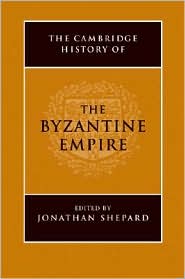The Cambridge History of the Byzantine Empire [Medieval History]

Jonathan Shephard ed.
The Cambridge History of the Byzantine Empire, c.500-1492
Cambridge: Cambridge UP 2009, xx+1207 p.
General introduction(Jonathan Shepard)
i. Approaching Byzantium
ii. Periodisation and the contents of this book
iii. Other routes to Byzantium
iv. Smoothing the way and short-cuts to Byzantium: texts in translation
Part I. The Earlier Empire(c.500–c.700)
1. Justinian and his legacy(500–600)(Andrew Louth)
2. Eastern neighbours
a. Persia and the Sasanian monarchy(224–651)(Zeev Rubin)
b. Armenia(400–600)(R. W. Thomson)
c. The Arabs to the time of the Prophet(Lawrence I. Conrad)
3. Western approaches(500–600)(John Moorhead)
4. Byzantium transforming(600–700)(Andrew Louth)
Part II. The Middle Empire(c.700–1204)
5. State of emergency(700–850)(Marie-France Auzépy)
6. After iconoclasm(850–886)(Shaun Tougher)
7. Religious missions(Sergey A. Ivanov)
8. Armenian neighbours(600–1045)(T. W. Greenwood)
9. Confronting Islam: emperors versus caliphs(641–c.850)(Walter E. Kaegi)
10. Western approaches(700–900)(Michael McCormick)
11. Byzantine Italy(680–876)(Thomas S. Brown)
12. The middle Byzantine economy(600–1204)(Mark Whittow)
13. Equilibrium to expansion(886–1025)(Jonathan Shepard)
14. Western approaches(900–1025)(Jonathan Shepard)
15. Byzantium and southern Italy(876–1000)(G. A. Loud)
16. Belle époque or crisis?(1025–1118)(Michael Angold)
17. The empire of the Komnenoi(1118–1204)(Paul Magdalino)
18. Balkan borderlands(1018–1204)(Paul Stephenson)
19. Raiders and neighbours: the Turks(1040–1304)(D. A. Korobeinikov)
Part III. The Byzantine Lands in the Later Middle Ages(1204–1492)
20. After the Fourth Crusade
a. The Greek rump states and the recovery of Byzantium(Michael Angold)
b. The Latin empire of Constantinople and the Frankish states(David Jacoby)
21. Balkans powers: Albania, Serbia and Bulgaria(1200–1300)(Alain Ducellier)
22. The Palaiologoi and the world around them(1261–1400)(Angeliki E. Laiou)
23. Latins in the Aegean and the Balkans(1300–1400)(Michel Balard)
24. The Roman orthodox world(1393–1492)(Anthony Bryer)
Glossary
Geneological tables and lists of rulers
List of alternative place names
Bibliography
Picture acknowledgements
Index
* * * * * * * * * *
ビザンツ研究者にとっては待ちに待ったケンブリッジ版ビザンツ史。執筆人は私でも知っている人ばかりなので、おそらくドリームチームなのであろう。
本書は単なる論集ではない。200ページにわたる用語集、系図、ビブリオがあり、簡にして要を得た歴史地図も効果的に織り込まれている。最も素晴らしいのは編者シェパードによる4節にわたる序論。史料学や時代区分論といったビザンツ研究にとっての基礎的な問題をリーダブルにまとめている。ここだけでも読む価値はある。このあたり北欧が余りにいい加減だったので、ケンブリッジは粗製乱造かと思っていたのだが、論集は編者次第だと再確認した。西洋史の人は、とりあえずWestern approachesと題された、3、10、14章を見ておけばよい。
シェパードの身分はよくわからないが、以前ケンブリッジ大学で教えていた。ロングマン版のロシア史の第1巻を執筆している。ヨーロッパ言語はもとよりスラブ系言語もほとんどできるようなので、論集では何かあると彼が執筆をしている。ビザンツ学の中ではピーター・ブラウン級の才人ではないかと思う。政治史ということもあってブラウンほどの派手さはないけれども、一目置かれる存在であることは確か。本書の執筆者たちも本来であれば編者となってもおかしくない人が多いのだが、「シェパードが編むなら」という感じで寄稿したのではないだろうか。
本書はあくまで狭い意味での歴史学。近ごろの論集は、ケンブリッジ版古代史や中世史がそうであったように、美術や文化を織り込むことが当たり前のようになってきているが、本書はあえてそういった「周辺」諸学を省いたのかもしれない。政治史だけでもこれだけできるというのもあるのかもしれないし、美術史や文学史を入れてもうまくかみ合わず全体のバランスを損なうことを恐れたのかもしれない。
後期ビザンツを扱う第3部は、最近出たケンブリッジ版トルコ史の第1巻と併読すべきものなのかもしれない。中世後期の東地中海世界は複雑すぎてまったくわからない。ビザンツなど第4回十字軍のあとは泡沫国家に成り果てていたが、でもこの世界の知識人たちがイタリアルネサンスを準備したんだよねえ。そう考えると興味深い。
私の手元にはもういっさつビザンツ関係の手引書がある。Elisabeth Jeffreys ed. The Oxford Handbook of Byzantine Studies. Oxford: Oxford UP 2009, xxix+1021 p.である。シェパード編に負けないページ数であるが、こちらは歴史補助学を中心に項目を立てている。だからシェパード編とはかならずしも被らない。執筆者もなぜかあまりかぶっていない。英語圏のビザンツ学の層が厚いのか、それともケンブリッジとオックスフォードでなんらかの棲み分けがあるのか、そのところはよくわからない。なんにせよこの二冊があればわたしのような専門外には十分である。もういっさつ似たような手引書がラウトリッジから出るだのという話も聞いたのだが…。

